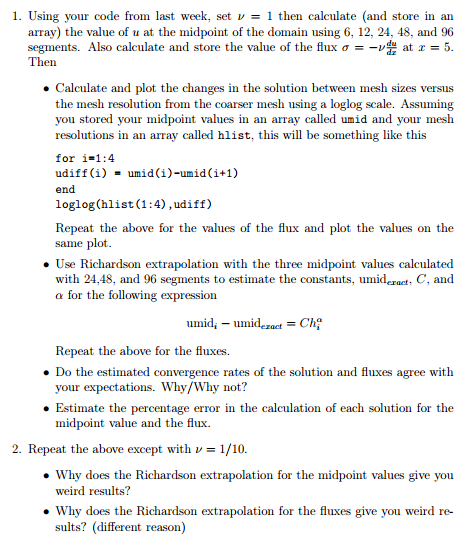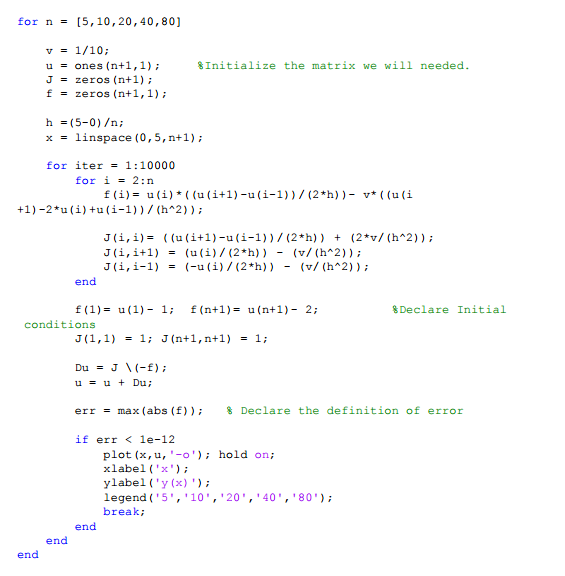
Code from Last Weak:

1. Using your code from last week, set 1 then calculate (and store in an array) the value of u at the midpoint of the domain using 6, 12, 24, 48, and 96 segments. Also calculate and store the value of the flux --vde at r-5 Then . Calculate and plot the changes in the solution between mesh sizes versus the mesh resolution from the coarser mesh using a loglog scale. Assuming you stored your midpoint values in an array called umid and your mesh resolutions in an array called hlist, this will be something like this for i=1:4 udiff(i) umid(i)-umid(i+1) end loglog(hlist (1:4) ,udiff) Repeat the above for the values of the flux and plot the values on the same plot . Use Richardson extrapolation with the three midpoint values calculated with 24,48, and 96 segments to estimate the constants, umideract, C, and for the following expression umidi-umider act-Ch? Repeat the above for the fluxes. your expectations. Why/Why not? midpoint value and the flux. . Do the estimated convergence rates of the solution and fluxes agree with . Estimate the percentage error in the calculation of each solution for the 2. Repeat the above except with v-1/10. . Why does the Richardson extrapolation for the midpoint values give you weird results? . Why does the Richardson extrapolation for the fluxes give you weird re- sults? (different reason) 1. Using your code from last week, set 1 then calculate (and store in an array) the value of u at the midpoint of the domain using 6, 12, 24, 48, and 96 segments. Also calculate and store the value of the flux --vde at r-5 Then . Calculate and plot the changes in the solution between mesh sizes versus the mesh resolution from the coarser mesh using a loglog scale. Assuming you stored your midpoint values in an array called umid and your mesh resolutions in an array called hlist, this will be something like this for i=1:4 udiff(i) umid(i)-umid(i+1) end loglog(hlist (1:4) ,udiff) Repeat the above for the values of the flux and plot the values on the same plot . Use Richardson extrapolation with the three midpoint values calculated with 24,48, and 96 segments to estimate the constants, umideract, C, and for the following expression umidi-umider act-Ch? Repeat the above for the fluxes. your expectations. Why/Why not? midpoint value and the flux. . Do the estimated convergence rates of the solution and fluxes agree with . Estimate the percentage error in the calculation of each solution for the 2. Repeat the above except with v-1/10. . Why does the Richardson extrapolation for the midpoint values give you weird results? . Why does the Richardson extrapolation for the fluxes give you weird re- sults? (different reason)








